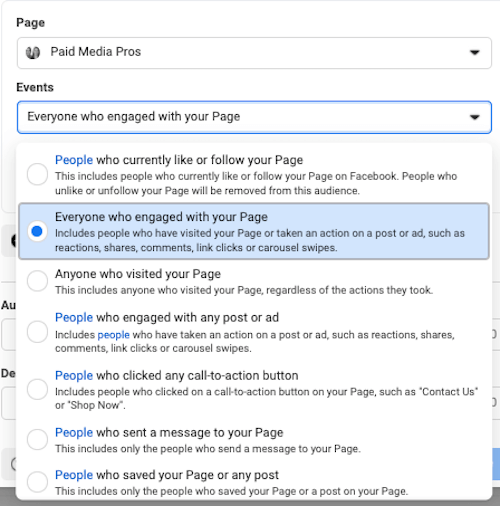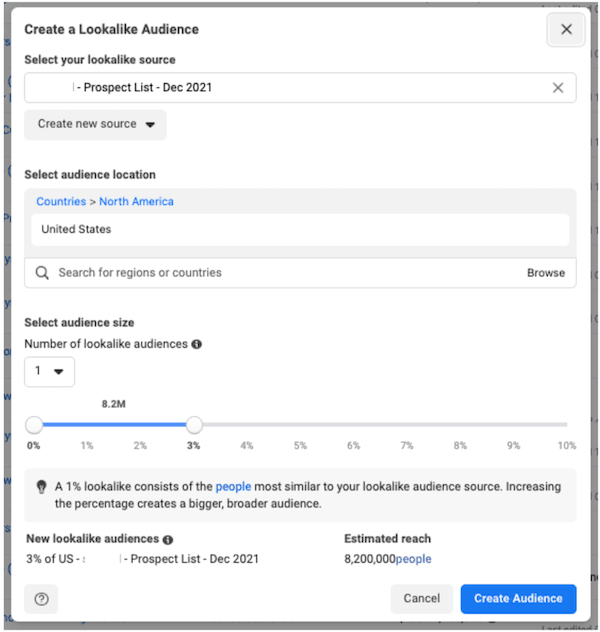Source
If you’re going to spend money on Facebook ads, you’re going to want to do what’s in your control to make that investment worthwhile. That is, not merely “running campaigns” but actually “tearing it up out there.” “Going out there and getting them”…”(tiger)”. Competing.

This u?
There are just three things standing in the way of that:


Engaging? Check. Eye-catching? Check. Interesting? Check.
In the diagram below, we have a mock campaign with an audience of 200,000, a budget of $5,500, a close rate of 70%, and a profit per sale of $2,600.
In the bottom-funnel strategy, we’re promoting a free trial, and then targeting those free trial users with a demo. The result is 35 deals and an $85k ROI.
In the full-funnel strategy, we’re promoting a piece of content, then targeting those content downloaders with a case study, and then targeting the case study downloaders with a demo. We may have a higher volume of lower quality leads to start, but in the end, we end up with 56 deals and a $140k ROI. Now that’s how to compete.

One way to work around this is to retarget users based on their interaction with your Facebook page instead. These audiences will be accurate since they rely on Facebook’s first-party data, so you can treat them as you would website visitors. Learn about this on-platform strategy (and more like it) here.

Alright, now you’re ready to actually go out there and get em (tiger!). Follow these tips to take down your competitors in Facebook ads.
But on Facebook, you can target interests, aka users interested in what your competitors (and therefore you) have to offer. Even if you’re not getting clicks, you’re generating brand awareness among their audiences.
But don’t just go after fans of your direct competitors’ pages and call it a day. Think less about your competitor’s exact audience and more about their attributes. SparrowBoost has some solid recommendations on how to find interests to target outside of just the Facebook pages of your competitors:


You may gain some intel into their targeting parameters:


This way, you’ll be getting in front of people who are likely to be very interested in what you have to offer, on Facebook, before your competitors do.
If you’re going to spend money on Facebook ads, you’re going to want to do what’s in your control to make that investment worthwhile. That is, not merely “running campaigns” but actually “tearing it up out there.” “Going out there and getting them”…”(tiger)”. Competing.

This u?
There are just three things standing in the way of that:
- You
- Privacy
- Your competitors
How to compete in Facebook ads: You vs. you
You have to have a strong base before you go to battle. All too often, advertisers will set out to take down their competitors before making sure their own strategy is in top shape. So make sure you take care of these Facebook advertising fundamentals first.1. Take care of the fundamentals first
In his post on the habits of highly effective Facebook advertisers, PPC expert Brett McHale can’t stress enough the importance of getting your basics nailed down. Namely, a solid understanding of your target audience which will help you create a strong account structure
2. Understand what it takes to create an excellent ad
Facebook’s auction is similar to that of Google Ads, where advertisers who create quality ads are rewarded with higher ad positions and lower costs. In 2019, Relevance Score was replaced by three metrics called “ad relevance diagnostics” which include quality ranking, engagement rate ranking, and conversion rate ranking. For each of these metrics, you can have a below-average, average, or above-average ranking. Here’s how to stay above average:- Quality ranking: Steer clear of low-quality attributes like sensationalized language and engagement bait (this will probably land you a Facebook ad disapproval).
- Engagement rate ranking: Create engaging, eye-catching ads that are interesting to your target audience.
- Conversion rate ranking: Use a clear CTA and optimize your landing page or post-click experience for conversion.

Engaging? Check. Eye-catching? Check. Interesting? Check.
3. Build a full Facebook ads funnel
When you’re paying to play, it’s tempting to only promote offers that will bring in direct profit. But a low-value-to-you offer is often of the most value to your prospects at the beginning stage of their buying journey. This offer will keep them on the journey and more likely to convert on higher value offers later on.In the diagram below, we have a mock campaign with an audience of 200,000, a budget of $5,500, a close rate of 70%, and a profit per sale of $2,600.
In the bottom-funnel strategy, we’re promoting a free trial, and then targeting those free trial users with a demo. The result is 35 deals and an $85k ROI.
In the full-funnel strategy, we’re promoting a piece of content, then targeting those content downloaders with a case study, and then targeting the case study downloaders with a demo. We may have a higher volume of lower quality leads to start, but in the end, we end up with 56 deals and a $140k ROI. Now that’s how to compete.

How to compete in Facebook ads: You vs. privacy
So you have your foundation built, but you’re not quite yet ready to take on your competitors. You have to take on privacy first, which, in recent years, has changed some of the traditional ways we target, track, and optimize our Facebook ads. So before you get into the competitive side, you need to know how to be creative (but compliant) with your Facebook targeting. Here are two ways to do that:4. Lean into on-platform engagement
One of the most effective Facebook retargeting campaigns is that of showing ads to previous website visitors. For example, you could retarget visitors who signed up for your newsletter, who submitted a contact form, or who viewed a specific product page. But with iOS 14+ users being able to opt out of tracking, these website retargeting audiences aren’t as reliable as they once were.One way to work around this is to retarget users based on their interaction with your Facebook page instead. These audiences will be accurate since they rely on Facebook’s first-party data, so you can treat them as you would website visitors. Learn about this on-platform strategy (and more like it) here.

5. Use in-market segments from search
This tip is coming in hot from PPC influencer (and former WordStreamer) Navah Hopkins. Facebook has removed or restricted several targeting categories from the platform in the name of privacy, such as those involving employment, real estate, or finance. What you can do, however, is run a search campaign on Google using in-market audience targeting. This type of targeting does still allow you to reach these categories of users. This will then get qualified users to your site where you can build a list to upload to Facebook for a lookalike or retargeting campaignHow to compete in Facebook ads: You vs. competitors
Alright, now you’re ready to actually go out there and get em (tiger!). Follow these tips to take down your competitors in Facebook ads.
6. Be more strategic with interest targeting
Bidding on competitor terms in Google Ads is easy to do, but since you aren’t your competitor, your relevance and therefore Quality Score will struggle. Which will hike up costs.But on Facebook, you can target interests, aka users interested in what your competitors (and therefore you) have to offer. Even if you’re not getting clicks, you’re generating brand awareness among their audiences.
But don’t just go after fans of your direct competitors’ pages and call it a day. Think less about your competitor’s exact audience and more about their attributes. SparrowBoost has some solid recommendations on how to find interests to target outside of just the Facebook pages of your competitors:
- Facebook pages of influencers or institutions in our industry
- Related Facebook pages: Type relevant keywords into Facebook search and choose page results. Or, for any of the above pages, go to “Pages liked by this page” or “related pages” in the sidebar.
- Top fan page likes: For any page, click on the Community tab to see the top fans. You can then go to their profile, add “/likes” at the end of the URL and then you can see what they have liked.
- Type relevant keywords into YouTube. Look at the Facebook profiles of top-ranking videos

7. Look at [more than just] their Facebook Ads
If you’re going to take down your competitors, you have to have a clear picture of not just who, but what, you’re taking down. Take a look at the ads they’re putting out there, on Facebook and elsewhere. Here’s how:- View their Facebook ads: Go to the Meta Ads Library directly and search the business name. or go to their Facebook page, find “Page transparency” and click on view all ads. It will take you to the same place.
- Look at their LinkedIn Ads: Is their messaging different? Are they even running LinkedIn ads?
- Peruse their organic content: Also, look at what your competitors are posting organically and see which topics, content types, pain points, and benefits their fans are engaging with most.

8. Look at who they’re targeting
This tip comes from Social Media Examiner via Anna Sonnenberg. Instead of just viewing your competitors’ ads in the Meta Ad Library, see if you can get one to appear in the wild. Follow their page, visit their website, and engage with their content and you’ll probably get targeted. When you see the ad in your feed, click on the three dots in the top right corner of the ad and choose “Why Am I Seeing This Ad?”You may gain some intel into their targeting parameters:

9. Be smart with your lookalike audiences
Facebook lookalike audiences ask you to provide a source audience and a location and then create a brand new audience of prospects that resembles that audience. You can create source audiences from a list of email addresses you upload, website visitors, people who engage with your app, or with your content on Facebook on Instagram. A few tips on this:- A list of customer email addresses is your best bet.
- Be careful with website traffic audiences, as this data is not guaranteed to be complete due to privacy changes. If you go with this option, choose site traffic from a high-value page, like a pricing, contact, thank you, or checkout page.
- Use 1% (most closely resembles your audience)
- Combine with interest, behavioral, and demographic targeting.

This way, you’ll be getting in front of people who are likely to be very interested in what you have to offer, on Facebook, before your competitors do.
Go get’em tiger
And there you have it: how to not just run Facebook ads, but how to make the most of its features, your data, and competitive intel to truly maximize your return on investment. To recap, here are our top tips to compete in Facebook ads:- Take care of the fundamentals first
- Understand what it takes to create an excellent ad
- Build a full Facebook ads funnel
- Lean into on-platform engagement
- Use in-market segments from search
- Be more strategic with interest targeting
- Get targeted by your competitors
- Look at [more than just] their Facebook ads
- Be smart with lookalikes



